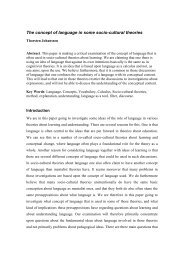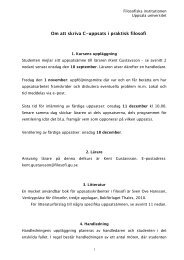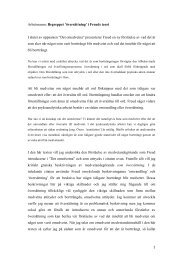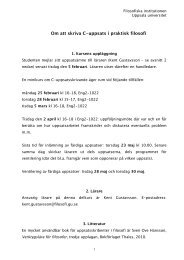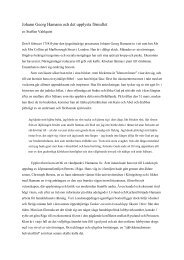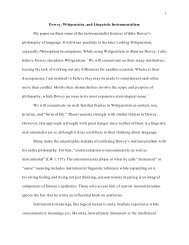Formal Logic, Models, Reality
Formal Logic, Models, Reality
Formal Logic, Models, Reality
You also want an ePaper? Increase the reach of your titles
YUMPU automatically turns print PDFs into web optimized ePapers that Google loves.
5.7 REMARK. The theory of truth 5.6 is, of course, in need of development. For instancethe basis of all empirical knowledge is verified results of measurements of operationallydefined entities. The projections onto reality of propositions representingsuch results are called facts. The sentences which express such propositions are thebasic truths rather than the so-called “Protokollsätze” favoured by the logical empiricists.This is in agreement with the thesis that human beings are Turing machines andthat therefore epistemology must be based on such operations which can be performedby the universal Turing machine.5.8 Reference and Existence. A problem logic of the sort outlined above can be appliedboth to reality and to models. Therefore an atheist and a monotheist can conducttheir discussion on the existence of God mainly as in the reconstruction 2.7. Onedifference is that now they must agree, explicitly or implicitly, that they are conductinga thought experiment. Another difference is that the models they use in thethought experiment are adapted to problem logic rather than to formal classical logicand therefore normally contain no truth-functions.5.9 Ontological Commitment. Problem logic can be applied both to reality and tomodels. If we have a non-formal theory T with underlying problem logic and thattheory by a person is claimed to apply to reality and be a true theory of reality, thenthis claim in itself implies a commitment of that person to the claim that whateverentity is implied by the theory to exist also exists in reality. If the non-formal theoryT is applied to a model, the commitment is only to the existence of representatives ofthe named entities in the model. Ontological research cannot be done the way proposedby Quine. More in the vein of older philosophy, we must ask directly about thenature of reality. To move ontology from a speculative methodology towards a moreanalytical methodology, we can in the case of the ontology of physical entities takeguidance of the fundamental theories of modern physics, quantum mechanics and amodified and corrected relativity theory. For the ontology of mathematical entities,some guidance comes from an analysis of the applications of mathematics.5.10 Theory of Truth. In the present writer's opinion, the correct theory of truth fornatural languages is the one given in § 5.6. It is not a correspondence theory of truthin the sense defined in Section 4, and it shows why a correct theory of truth for naturallanguages cannot be a correspondence theory. The reason is that truth is contextdependent. A sentence gets a part of its meaning from the problem to which it expressesa proposed solution. It is true if it expresses a correct complete solution tothat problem. Therefore the same sentence can be true in one problem context andfalse in another. In a correspondence theory of truth, any such context dependence isexcluded.22



